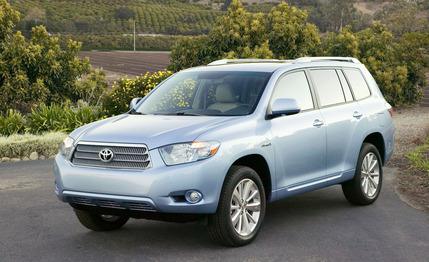 Review
Review
Introduction
The Toyota Highlander is one of the company’s three entries in the burgeoning mid-size sport-utility segment—Toyota also sells the mid-size 4Runner and FJ Cruiser SUVs. In 2008, the Highlander was completely redesigned for the first time since being introduced in 2001. The new interior is now more luxurious and Lexus-like than the previous generation. On the outside, the Highlander features more aggressive and muscular styling. The redesign also stretched the Highlander inside and out. Interior space measures a comfortable and massive 145.7 cubic feet. In the previous version, the third-row seats seemed like an afterthought, but the latest Highlander’s third row is spacious enough for smaller adults to use. Even compared with heavier full-size sport-utility vehicles, the Highlander features competitive interior space and comfort for seven occupants.
Unlike those two other Toyota mid-size SUVs, the Highlander is built on a unibody platform, like a car, and could be considered a crossover vehicle. Compared with a traditional body-on-frame SUV, the unibody structure is less heavy and cumbersome, which gives the Highlander driving dynamics similar to those of a large car but with a high seating position. For those interested in towing, a Highlander with the towing package can pull up to 5000 pounds. The suspension is tuned to give a quiet and supple ride that will absorb most road imperfections with ease, even when equipped with the optional 19-inch wheels.
The Highlander is available with front-wheel drive or with automatic four-wheel drive; the latter is available only with the V-6 and adds nearly 200 pounds and roughly $1500 to the price depending on trim level. A 270-hp, 3.5-liter V-6 powers most Highlanders, although a new, 2.7-liter four-cylinder engine with 187 horsepower becomes the base engine for 2009. Estimated fuel economy for V-6 versions is 18 mpg city and 24 highway for front-drive versions, and 17 mpg city and 23 highway for four-wheel-drive models. The four-banger could get an extra 3 to 5 mpg, putting it on equal fuel-miser footing with the front-drive version of its little brother, the RAV4. For those seeking even more fuel efficiency, Toyota makes a gasoline-electric hybrid version of the Highlander.
Major competitors to the Toyota Highlander include the Chevrolet Traverse, Dodge Journey, Ford Flex, Ford Taurus X, Honda Pilot, Hyundai Veracruz, Mitsubishi Outlander, and Subaru Tribeca.
Verdict
The latest Highlander from Toyota offers the same practicality and livability that made the first two generations a popular choice among families. Interior versatility, good fuel economy, a strong V-6 engine, carlike refinement, and a handsome and spacious interior should be enough to put the Highlander on any mid-size-SUV buyer’s shopping list.
Click here to read our full review of the Toyota Highlander.
Click here to read our latest feature involving the Toyota Highlander.
What’s New for 2009
The Highlander gets a new, 2.7-liter four-cylinder engine in base versions.
Highlights and Recommendations
The base Highlander lineup comes fairly well equipped, but buyers seeking more luxury and optional equipment such as a leather interior, a sunroof, a premium stereo, or satellite navigation will have to opt for the Sport or Limited trim level. Two-wheel-drive base versions can be had without a third row.
Although we hadn’t yet driven a Highlander with the new, 2.7-liter four-cylinder engine at publishing time, we don’t expect it to move the roughly 4000-pound Highlander with any real gusto. The V-6 is far better suited to hauling around a Highlander loaded to the gills with occupants and their stuff.
Safety
Dual front airbags, front-seat-mounted side-impact airbags, a driver’s knee airbag, front-seat active headrests, three-row curtain airbags, front-seatbelt pretensioners, tire-pressure monitoring, anti-lock brakes, traction control, and stability control are all standard on the Toyota Highlander.